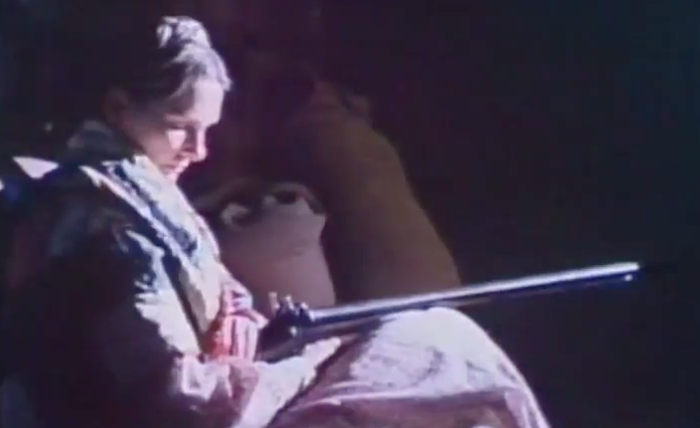
“I’m someone who’s had more dead bodies in my closet than most people.”
Cecelia Condit attempts to hide the smile accompanying this enigmatic statement, disclosed during a recent screening of her video shorts featuring works spanning over 30 years. Moments later, describing her “luck” in sourcing two sisters fluent in trauma to shoot a recent project, she admits: “I couldn’t have someone who hadn’t been crushed in any way,” alluding to their father’s accidental death from a crushing physical weight. In language, as in Condit’s films, the literal and the figurative often meet.
The Redditors of r/creepy somehow grasped this when Condit’s most popular work, Possibly in Michigan (1983), circulated in 2015 as a sourceless meme similar in tone to contemporary stoner culture favourites like Adult Swim’s Too Many Cooks. Stripped of context, the bizarre, lo-fi cannibal musical terrified: “Pretty sure at least one person has heard this right before being brutally dismembered.” Horror movies make children of their audiences, and Reddit users seemed convinced the violence of the film would slip from the screen and enter their lives. But Possibly in Michigan isn’t necessarily horrific, at least not to the viewers at the recent screening, whose chuckles filled the room during the film’s goriest scenes. In 1982—a year before Condit released the film—Herbert Blau wrote: “when laughter comes the meaning is deadly, or there’s just no meaning at all.”[i]

Possibly in Michigan’s deadliness manifests as a tickling awareness of the most noxious aspects of masculinity, and women’s capacity to carry out sly reversals of their victimhood.
Condit has a unique capacity for transmuting women’s violent and dehumanizing realities through grim humour. In Possibly in Michigan’s palatial shopping mall, two women—with the perky and perfectly precise names Sharon and Janice—spritz perfumes as a tuxedoed man in a mask with a gaping mouth lingers ever-present, It Follows-style, in the background. He is a figure of surveillance, everywhere and nowhere: a shot-reverse-shot of the women facing each other at a department store counter reveals him staring at them or aping their movements in each frame—always behind, able to transgress space with a supernatural entitlement. Sharon and Janice flee—two pairs of indistinguishable heeled legs—and the expected horror script [ii] shifts.
The man—who now has a human face as artificial as the series of animal masks he appears in—invades Sharon’s house through a broken window and promises her love before beating her in the film’s most graphic scenes, until Janice arrives to shoot him dead. The two women dismember and cook him—what else?—as the music resumes its circus-like tinkling. Sharon and Janice appear wry and knowing as they smoke in the nude, sample the cannibal broth and clink glass goblets of blood. Sated, they dump the bag of bones on their suburban street corner, where the credits roll over a garbage truck as if to hint at further transgressions stowed away in its trash mounds, the castoffs of other women who made it out alive through their alliances.

Condit’s videos are often characterized as fairy tales, and the texts include clear references: in girlish sing-song, Sharon asks her self-described prince charming about his prior lovers—or victims—and discovers, like Bluebeard’s final wife, that she’s his seventh. Likewise, the story of a prince who reveals himself to be a scoundrel echoes the Brothers Grimm tale Sweetheart Roland, in which a girl lives disguised as a flower while her Roland courts another—until, finally, among a gathering of fellow maidens, she sings to reclaim his heart. Sharon and Janice also sing as if addressing a kindred audience, over drum machines and synths, sounding like Jenny Hval performing a Brecht cover: “I bite at the hand that feeds me / slap at the face that eats me.” The earworm betrays the pair’s grotesque glee: they’re not sorry to bite or slap, and the present tense serves as a threat.
Young girls in fairy tales “meet the forces of the mythical world with cunning and with high spirits” [iii] only to marry dirtbag princes like Roland. In Possibly in Michigan, Sharon and Janice consume the prince in the manner of witches imbibing power and end up alone, together. No wonder conservative advocate Pat Robertson cast the video as “lesbian and anti-male” [iv] in stagey declarations of concern over its National Endowment for the Arts funding; its deadliness manifests as a tickling awareness of the most noxious aspects of masculinity, and women’s capacity to carry out sly reversals of their victimhood.

“I dreamed that it was me, and not her, that he killed.”
Viewers only exult in these reversals if they find violence against women more harrowing than the cannibalistic self-defence that follows. At the screening, absolute silence descended during the scene when “prince charming” begins striking Sharon without pause, in brutal and direct blows to her astonished face. Unlike the earlier mall and street sequences, these images are askew and bordered in black, as though a projection of the original is being filmed. Perhaps Condit cannot bear to look directly; there’s no pleasure in seeing. She has said that she lifted the dialogue in this scene—an eerie sing-song twist on Little Red Riding Hood—from a friend’s dreamed conversation after a sexual assault: “You have two choices. One: I will eat you now. Or two: I will cut your arms and legs off one by one and eat them slowly. / Why? / For love.” To which Condit adds her own amendment: “But love shouldn’t cost an arm and a leg.”

To be nobody’s meat is not a life but a chance at one. It requires risk, ingenuity. It requires women laughing in the face of terror.
Two years prior to Possibly in Michigan, Condit made Beneath the Skin when a friend’s boyfriend became a tabloid sensation after murdering his previous girlfriend and storing her mummified body in his closet. The tale seems unbelievable; in a gossipy voiceover that evokes the nail salon more than the confessional, the film’s absurdly bubbly narrator admits: “It was just a bizarre story that somehow happened to my life, but it never was real.”
In contrast to the horrific images of corpses that flicker throughout the film, her commentary is not dire—it’s the sickening sweetness of a woman who cannot process the unreckonable. She lays in bed, eyes closed, as the bright projection of another woman’s face overlays her own and seems to speak: “I dreamed that it was me, and not her, that he killed.” The two women double, twist, conflate, interchangeable to viewer and killer alike.
Possibly in Michigan asks: What if Beneath the Skin’s narrator and murder victim became accomplices? In this amended, if not quite utopian, account, the women are each other’s apotropaic allies, abandoning the marketing jargon of “female friendship” in favour of an ethos of female survival. Sylvia Plath, in a poem from Ariel, writes: “I am red meat.” [v] If Beneath the Skin shows women as meat, in all their gory physicality—beheaded, skeletal, black-and-white and mummified—then Possibly in Michigan draws from revisionists like novelist Angela Carter: “The girl burst out laughing: she knew she was nobody’s meat.” [vi]
To be nobody’s meat is not a life but a chance at one. It requires risk, ingenuity. It requires women laughing in the face of terror.






